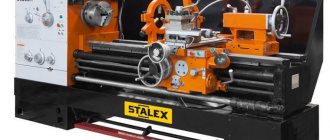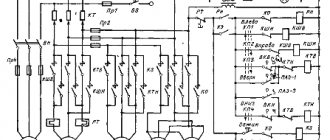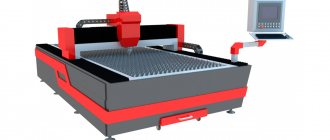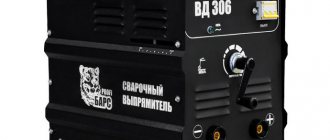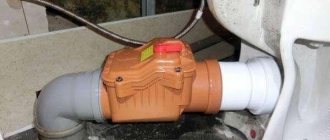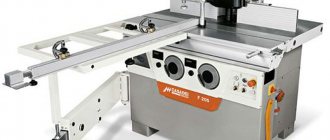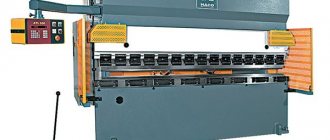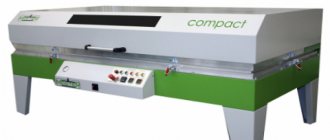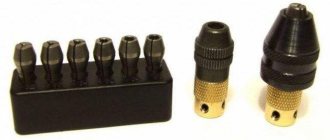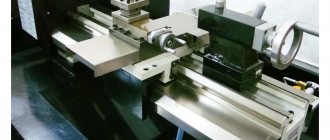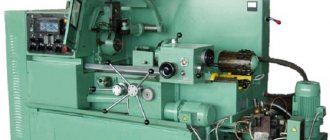Metal-cutting machines are a broad group of industrial equipment for processing metal workpieces. In addition to working with metal, they are suitable for cutting metal, plastic, and other materials. Due to the diversity of attitudes, they are divided into separate groups according to different factors.
Metal cutting machine for processing workpieces
General classification
The classification of metal-cutting machines is carried out according to various factors. These are divisions by weight, dimensions, type, accuracy class, degree of automation, and versatility. We need to talk about each of their groups in more detail.
Classification by type
There are 9 types of installations based on the type of equipment:
- Lathes. They occupy approximately 30% of the total mass of metal-cutting devices. The workpiece is clamped in a special clamp. The cutting process begins after installing the cutters, which remove a layer of metal under the influence of rotation.
- Boring, drilling units. They occupy 20% of the total mass of machines. The parts are fixed on the work table. Cutting occurs due to the rotation of the spindle with a drill clamped in the chuck.
- Grinding, grinding, polishing machines. They occupy 20% of the total mass of metal cutting installations. Metal cutting occurs due to the rotation of the abrasive material, which comes into contact with the working surface. The processing speed depends on the size of the abrasive.
- Devices for physical and chemical cutting of workpieces. Least common equipment.
- Devices for processing threads and teeth. Occupies 6% of the mass. Used for threading, manufacturing, and sharpening gears.
- Slotting, broaching, planing machines. They occupy 4% of the mass of metal-cutting equipment.
- Milling machines. They occupy 15% of the total mass. Processing of metal workpieces occurs due to the rotation of cutters of different shapes.
- Split installations. Used to separate reinforcement, profiles, corners.
- Machines for performing various operations related to cutting.
Classification by versatility
A separate division of metal-cutting machines is based on their versatility. There are two groups:
- Narrow profile installations. Used to perform one specific technological operation.
- Universal units. They are large-sized structures that are designed to perform various technological operations.
For better performance of technological operations, it is better to buy several machines with a narrow profile.
Classification by degree of accuracy
In terms of accuracy, metal-cutting machines come in several types, each of which has its own marking:
- Increased - denoted by the letter P.
- Normal - designation N.
- High - indicated by the letter B.
- Particularly high - designation A.
- The highest accuracy is indicated by the letter C.
To use units marked B, A, C, you need to prepare the room in advance. It must maintain a constant temperature and humidity level.
Classification by degree of automation
Based on the degree of automation, the following types of metal-cutting machines are distinguished:
- Manual models. The worker needs to clean, prepare workpieces, set up all moving elements independently, and coordinate the work process.
- Semi-automatic machines. The worker needs to change parts independently, turn on and off moving mechanisms.
- Automatic machines are units that process workpieces independently. Used in mass production.
- CNC equipment. The operator sets the required algorithm through the program. The moving mechanisms work independently, select optimal modes, load and unload parts.
CNC machines are gradually replacing other machines due to high processing accuracy and increased productivity.
Metal cutting automatic machine
Classification by weight
Industrial metal-cutting machines are divided by weight. Highlight:
- Lightweight - structures weigh up to 1000 kg.
- Medium - weight starts from 1 ton and ends at 10 tons.
- Large - weight from 16 to 30 tons.
- Heavy - weight from 30 to 100 tons.
- Super heavy - structures weigh more than 100 tons.
Designations are indicated in the technical data sheet.
Types of machines
Milling machines
On milling machines, you can process external and internal surfaces of various configurations, cut straight and helical grooves, cut external and internal threads, process gears, etc.
The machines are distinguished:
- cantilever-milling (horizontal, vertical, universal and wide-universal)
- vertical milling non-cantilever,
- longitudinal milling (one- and two-column),
- continuous milling machines (rotary and drum),
- copy milling (for contour and volumetric milling),
- engraving and milling,
- specialized (thread milling, key-milling, slot milling, etc.).
Modern milling machines use separate drives for the main movement and feeds, mechanisms for accelerated table movements (in all directions), and single-handle control for changing the feed speed. In machine tools, components and parts are widely unified. Machines are called cantilever machines because the machine table is mounted on a console that moves upward along the guides of the bed.
Cantilever milling machines include horizontal milling, vertical milling, universal and wide-universal. The main size of general purpose milling machines is the size of the working surface of the table. In horizontal cantilever milling machines, the spindle axis is located horizontally, and the table moves in three mutually perpendicular directions.
Universal cantilever milling machines outwardly almost do not differ from horizontal machines, but they have a rotary table, which, in addition to the ability to move in three mutually perpendicular directions, can be rotated around its vertical axis by ±45º. This allows you to machine helical grooves and cut helical wheels.
Vertical cantilever milling machines differ in appearance from horizontal ones in the vertical location of the spindle axis and the absence of a trunk. The trunk of horizontal machines serves to secure the bracket that supports the end of the milling mandrel.
Widely universal cantilever milling machines, unlike universal ones, have an additional spindle that rotates around the vertical and horizontal axes. There are also widely universal machines with two spindles (horizontal and vertical) and a table that rotates around its axis. In universal milling machines, the spindle can be installed at any angle to the workpiece being processed.
Horizontal, vertical and universal milling machines
Continuous milling machines
When working on continuous milling machines, workpieces are placed and secured on tables without stopping movement. The productivity of such machines is high; they are used in large-scale and mass production.
Continuous milling machines are divided into rotary and drum. On a rotary machine, the workpieces are installed in fixtures on a rotating table, then they are passed to remove the allowance under one or two cutters and removed from the table. A part processing cycle can be completed in just a few table revolutions.
A drum machine for continuous operation is used for processing relatively large workpieces simultaneously on both sides. The workpiece is secured in devices that are installed on the periphery of a slowly rotating massive drum. Processing is carried out using cutters. Workpieces are installed and parts are removed while the machine is operating from the side opposite to the cutter.
Dividing heads
Dividing heads are used when working on cantilever milling machines to set the workpiece at the required angle relative to the machine table, rotate it at a certain angle, divide the circle into the required number of parts, and also for continuous rotation of the workpiece when milling helical grooves. There are dividing heads for direct division (dividing devices), optical dividing heads and universal dividing heads. Universal dividing heads are divided into limb and limbless. The most common are dial heads. Universal dividing heads can be used for simple and differentiated division.
Machine markings
Short designations consisting of letters and numbers indicate different technical characteristics, purpose, and manufacturer of the units. Markings are divided into two groups:
- Marking of serial production machines. The first digit indicates the group, the second the type. The letter after the first two digits indicates a modernization of the design. Next, the operational parameter is indicated by two numbers. After it, the CNC type is indicated in one letter with a number. The last letter with a number designates the CNC computing device.
- Marking of specialized installations. The first two letters indicate the abbreviated name of the manufacturer. After it, the main operational parameter is indicated in three digits. The modification is further indicated by a letter. The last letter and number indicate the CNC computing device.
After such markings, separate symbols may be added that indicate technical characteristics. A more accurate decoding can be found in the tables available on the Internet.
Sawing machines
This category presents units that cut workpieces into two or more parts. There are circular machines, that is, disk machines, and belt machines. The first ones carry out cross-cutting of products, usually in an in-line mode. Circular models are also widely used in households, since such operations are quite in demand. Band types of machines allow you to perform longitudinal cuts. For example, a single saw unit can split a long board into two pieces of similar length. Double saws, in turn, simultaneously cut in two levels, allowing you to get three from one board. Special modifications also make it possible to create a curved cut or even a cut at a certain angle. These are units with automatic feed control that perform high-precision processing.
Automation levels
Manual installations are giving way to CNC equipment. This automation system consists of several interconnected elements:
- Remote Control.
- Monitor for task of algorithms, control of work process.
- Sensors that determine the position of the workpiece on the work table and the movement of the equipment.
- Stepper motors that are controlled by a computer.
The operator must have practical experience in setting up and repairing such systems.
CNC metal cutting machine
Classification by processing material
Manufacturing machines are often assigned a specific purpose in terms of processing material. Wood and metal are the main materials with which such equipment works. For wood blanks, the machines are not designed with such high power, but on the other hand, they provide more flexible settings for work operations. Machine tools for metal parts obviously require a higher level of power load, as well as a reliable element base. The most popular types of metal machines are lathes, milling machines, drilling machines, etc. A special category is formed by screw cutting machines, which have almost no analogues in the group of woodworking machines. These are units that produce thread cutting. In addition, there are special machines for working with stone, plastic, composite and other less popular construction and raw materials.
Machine design
Almost all equipment that is used to work with metal parts is similar in design. There are two large groups based on the movement of working parts:
- Supply of equipment to the workpiece.
- Feeding the part to the cutting parts of the installation.
There are elements that are typical for any metal-cutting machines:
- Control system.
- A bed onto which other parts are attached.
- Desktop.
- Electric motor with the ability to install equipment and secure workpieces.
Other elements may vary depending on the type of equipment.
What are machines called?
The main distinguishing feature of this equipment in the general category of industrial units and construction tools is the presence of a frame on the basis of which the working body or system of bodies is arranged. The processing element can be a small abrasive wheel, a drill, or a diamond bit - it depends on the operation being performed. Most often, the overall appearance of the machine is presented as a massive structure with working equipment, a feed platform, clamps, a motor, etc. But in household and small-scale workshops, installations of modest sizes are also quite suitable. Moreover, if previously only stationary units were necessarily classified as machine tools, today there are many mobile devices among them. Moreover, the line between a hand-held power tool and a small-sized machine is not always clearly defined even by manufacturers. And yet, the presence of a bed, power plant and processing elements allows the equipment to be classified as full-fledged machine tools. Which ones exactly is another question.
Selection principles
When choosing a metal cutting machine, you need to consider some factors:
- Control system.
- Dimensions, installation weight.
- Ability to perform one or more technological operations.
Advantages and disadvantages
Metal-cutting equipment has a number of strengths and weaknesses. Advantages:
- Automation of the work process with CNC.
- High precision metal processing.
- High performance.
- Reliability, durability.
Flaws:
- The need to install a cooling system.
- Difficulties in repair.
- Experience in CNC setup.
It is important to carefully monitor the work process to reduce the risk of injury or part rejection.
Metal cutting precision
Manufacturers and cost
Among the manufacturers of metal-cutting machines there are:
- Caliber - Russia.
- Energomash - Russia.
- Jet - Russia.
The price depends on the type, size, performance, availability of additional functions, control system. The cost of standard industrial metal-cutting equipment starts from 500,000 rubles.
Milling machines
This type of operation is focused on the formation of profiles of a certain type. Most often, flat workpieces are processed by milling by removing the edges to a certain height. Machines of this type are used mainly in furniture production, where they are used to produce shaped elements and accessories that serve primarily a decorative function. Using a milling machine, full-fledged building materials are also produced - lining, plinth, tenons, platbands, etc. More modern types of milling machines support template processing. These are copy-milling units, the cutting parameters of which are selected automatically in accordance with the dimensions of the template part.
Exploitation
To safely operate a metal-cutting machine, you need to follow safety rules and take into account some features:
- Work using protective equipment, glasses, headphones, gloves.
- Check the integrity of the equipment (drills, cutters, cutters, abrasives) before starting the installation.
- Cool the work area. Water or oil can be used for this.
- Clean the structure from metal shavings after work.
- Lubricate moving parts at least 2 times a month.
You cannot work on machines that make extraneous noise, with missing fasteners, or exposed wires.
Metal-cutting machines combine various installations that are used for metal processing. They are divided according to different factors and have certain markings. By learning to read the numbers and letters indicated on the equipment body, you can learn a lot of information without reading the description or technical data sheet.
Surface treatment machines
A wide range of machine tools is presented in the segment of models for surface processing of parts. Such operations are generally positioned as grinding, but this is only the main part of their functions; related tasks are also encountered. What type of processing a particular machine will perform depends on its design. Thus, drum machines are focused on grinding boards, panel and sheet materials on the surface. In essence, shallow cleaning of the material from burrs, protruding irregularities and other defects is carried out. Finer processing is performed by edge grinding models. At first glance, the same function is performed by the main types of lathes, which carefully adjust the surface of the workpiece to the desired shape. However, in this case, edge processing does not only focus on cylindrical parts. This operation is most often used to correct the length of the edge. But there are also machines in this group that are also focused on cylindrical parts. These are oscillating models of grinding machines, but they are used not for decorative improvement, for example, balusters, but for preparing building materials in the form of logs of a certain size.
The meaning of the word Machine according to the Brockhaus and Efron dictionary:
Machine - has several meanings: 1) on the Ob River, branch offices of fishing establishments, differing from them in the smaller number of buildings and their temporary nature. They usually consist of a wicker shed for salting fish, several tents of foreigners, and hangers for drying manure and bramble, where Russians work in the north. 2) huts that serve in the north as a haven for hunters during the autumn hunt for squirrels and hazel grouse, and in general for peasants during haymaking. These huts are built along the banks of forest rivers and have the structure of an ordinary peasant bathhouse. 3) a hole dug in the frozen ground in early spring, covered with a square basket woven from thick twigs, in the sides of which loopholes are cut, from which geese are shot in Siberia during their migration at dawn and evening dawn.
Lathes
One of the most popular categories of production machines, which cover all operations related to turning parts. A turning machine allows you to adjust the shapes of workpieces that initially have bodies of revolution, to carry out cutting, turning grooves and, in some cases, drilling. It can be said that the target direction of operation of such equipment is the maintenance of workpieces in the form of bodies of revolution, which during the turning process receive a conical or cylindrical shape. There are different types of lathes that are used in different industries. For example, wood mills may use large machines to create rounded lumber. In the furniture industry, turning units are used to form legs, stair balusters, handles, etc. Such machines are also divided by type of placement - floor or tabletop.
